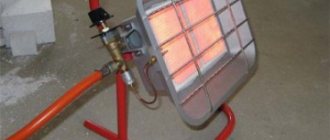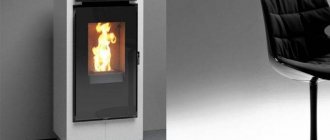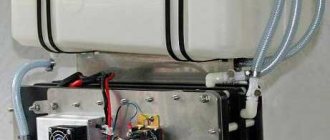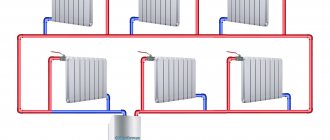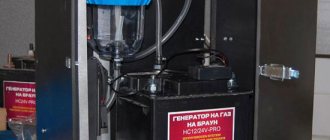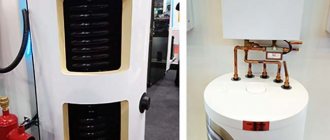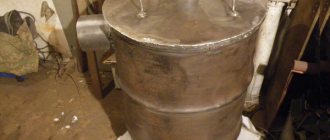Why choose steam heating?
It must be admitted that steam heating systems cannot be considered very popular. Such heating is rather rare. Let's take a closer look at its advantages and disadvantages.
Among the first, undoubtedly, are:
- Heating system efficiency. It is so high that a small number of radiators will be enough to heat the premises, and in some cases you can do without them: there will be enough pipes.
- Low inertia of the system, due to which the heating circuit warms up very quickly. Literally a few minutes after starting the boiler, the rooms begin to feel warm.
- There is virtually no heat loss in the system, which makes it very economical compared to others.
- Possibility of rare use, since due to the small amount of water in the pipes the system does not defrost. Alternatively, it can be installed in country houses where people come from time to time.
The main advantage of steam heating is considered to be its efficiency. The initial costs of its arrangement are quite modest; during operation it requires relatively small investments.
However, even with so many advantages, the disadvantages of the system are very significant. They are connected primarily with the fact that water vapor, the temperature of which is very high, is used as a coolant.
Water vapor condenses inside the steam heating radiator. This process releases a large amount of thermal energy, which explains the high efficiency of the system
Thanks to this, all elements of the system heat up to 100 °C and even higher. It is clear that any accidental touch to them will cause a burn. Therefore, all radiators, pipes and other structural parts must be closed. Especially if there are children in the house.
The high temperature of radiators and pipes provokes active air circulation in the room, which is quite uncomfortable and sometimes dangerous, for example, in case of an allergic reaction to dust.
When using steam heating, the air in the rooms becomes too dry. Hot pipes and radiators dry it out. This requires additional use of humidifiers.
Not all finishing materials used to decorate rooms heated in this way can withstand proximity to hot radiators and pipes. Therefore, their choice is very limited.
The most acceptable option in this case is cement plaster painted with heat-resistant paint. Everything else is questionable. Steam heating has another drawback that affects the comfort of those living in the house: the noise produced by steam passing through the pipes.
More significant disadvantages include poor adjustability of the system. The heat transfer of the structure cannot be controlled, which leads to overheating of the premises.
Steam heating is a potentially hazardous system, so the choice of equipment must be taken very responsibly. Pipes for the system must be metal only
There are possible solutions. The first is the installation of automation, which will turn on the boiler when the rooms cool down. In this case, those living in the house will be quite uncomfortable from constant temperature fluctuations.
A more “gentle” but labor-intensive method is to arrange several parallel branches that will need to be put into operation as needed.
The main disadvantage of steam heating, due to which it is little used, is its increased emergency danger. You need to understand that if a burst occurs, hot steam will erupt from a pipe or radiator under pressure, which is extremely dangerous.
That is why such systems are now prohibited in apartment buildings and are less commonly used in production. In private homes, they can be equipped under the personal responsibility of the owner.
Conditions for safe operation of the boiler
The boiler must be not only efficient, but also safe. The key to reliable and efficient operation of a steam heating boiler is maintaining a given level of heating of the metal elements.
In view of this, the coolant must constantly circulate inside the heated tubes while simultaneously cooling the heating surfaces. It is important that the coolant stably removes heat from the pipe material, which is heated under the influence of flue gases. If heat removal is insufficient, the metal will simply overheat, become less durable, and the efficiency and safety of the equipment will decrease. In the worst case, the pipes will simply burst.
Check the operation of the boiler regularly. Correct all problems immediately after they are discovered. Even the slightest defect can quickly lead to a significant decrease in the efficiency of the unit and a deterioration in the safety performance of the system. Water will come out of the drum, steam will penetrate into the drop tubes, the drum and tubes will heat up too much, and an accident will occur.
Also, you, as the owner, must ensure that all design elements and equipment used are of exceptionally high quality.
Video - DIY steam boiler
Similar articles
- Installation of a gas boiler: standards, requirements, rules
Gas still remains the cheapest type of fuel. Accordingly, the cheapest heating is obtained using natural gas. True gas installation... - Do-it-yourself concrete vibrator (site and deep): diagram, step-by-step instructions, drawings
To compact, and therefore strengthen the structure of concrete, you need to use a special tool - a vibrator. With its help, it’s easy to kick out… - DIY foundation made of 20x20x40 blocks: step-by-step technology, video instructions, photos and diagrams
The stage of constructing the foundation of any structure is considered the most expensive - the costs for it can be about 35-40% of the total estimate. Practically...
Basic elements of a steam system
The steam system includes several essential elements. Let's look at each of them in more detail.
Steam boiler - the heart of the system
The main function of the heating device is to convert water into steam, which subsequently enters the pipeline. The main structural elements of the device are the collectors, drum and pipelines.
In addition, there is a container with water, which is called the water space. A steam space is formed above it during operation of the device. They are separated by the so-called evaporation mirror.
The figure schematically shows one of the types of domestic steam boiler
Additional equipment designed for steam separation can be installed inside the steam space. The operation of the boiler is based on the principle of heat exchange between flue gases, water and steam.
There are two types of steam heating devices: fire-tube and water-tube. In the first case, heated gases move inside a pipeline laid inside a container of water.
They give off heat to the liquid, which reaches a boiling point. Water tube varieties work slightly differently. Here, water moves through pipes laid inside the chamber with flue gases. It heats up and boils.
Water and steam inside the boiler can move forcefully or naturally. In the first case, a pump is included in the design, in the second, the difference in densities of water and steam is used.
All types of steam boilers use approximately the same principle of converting water into steam:
- The prepared liquid is supplied to a reservoir located at the top of the boiler.
- From here the water flows through pipes into the collector.
- The liquid from the collector rises into the upper drum, passing through the heating zone.
- Inside the pipe with water, as a result of heating, steam is formed, which rises.
- Steam, if necessary, is passed through a separator, where it is separated from water. After which it enters the steam line.
A steam boiler can use a wide variety of fuels. Depending on this, certain changes are made to its design. They touch the combustion chamber. For solid fuel, a grate is installed on which coal, firewood, etc. are placed.
Special burners are used for liquid and gaseous fuels. There are also practical combination options.
Among home craftsmen, the installation of steam heating using a stove is especially popular. The photo shows one of the possible options for remodeling the stove
Depending on the heated area, the boiler power is selected.
This can be done based on average values:
- 25 kW for buildings up to 200 sq. m;
- 30 kW for houses with an area of 200 to 300 sq. m;
- 35-60 kW for buildings from 300 to 600 sq. m.
If more accurate data is needed, use the standard calculation method, where for every 10 sq. meters accounts for 1 kW of equipment power. We must not forget that the formula is used for houses with a ceiling height of 2.7 m or less.
For taller buildings, more power must be taken. When choosing a boiler, special attention should be paid to its certification. Any steam heating system is potentially dangerous, so testing the equipment is mandatory.
Heating pipes and radiators
The coolant temperature in steam systems ranges from 100 to 130 °C, which is much higher than in liquid systems, where it ranges from 70 to 90 °C. Therefore, it is strongly not recommended to use similar equipment for arranging systems.
First of all, this applies to metal-plastic and polypropylene pipes. The maximum operating temperatures for these materials vary between 90-100 °C, so their use is strictly prohibited.
An ideal option for installing a steam heating system is copper pipes. They are not subject to corrosion, can withstand high temperatures, but are very expensive
For main pipelines of steam systems, three types of pipes are usually used. The most inexpensive option is steel. They can easily withstand temperatures of 130 °C, which is more than enough, and are quite durable.
However, the condensate formed inside the parts quickly destroys the pipes, since steel is susceptible to corrosion, and the aggressive environment formed by steam only enhances this disadvantage.
Another disadvantage of steel elements is the need for connection by welding, which takes a lot of effort and time. Galvanized steel pipes are much more resistant to corrosion. They also withstand high temperatures well.
The threaded method is usually used to connect them, which greatly simplifies the process. The main disadvantage of galvanized pipes is their high cost.
Copper pipes are considered the ideal option. The material can withstand high temperatures, is quite plastic and at the same time durable, and is not subject to corrosion. Soldering is used to connect copper parts.
Copper pipelines are very durable and strong, but their cost is very high. Thus, the most acceptable option in terms of quality and price is steel pipes with anti-corrosion coating or galvanized.
The best choice for steam heating is cast iron radiators. They will be able to withstand severe loads caused by the presence of hot steam inside the batteries.
Radiators for steam systems are selected based on strength. It is important that they withstand high temperatures and are resistant to corrosion. Based on this, massive cast iron batteries can be considered the best option, while steel panel batteries are the worst.
Given the high efficiency of the system, in some cases it is quite acceptable to use finned steel pipes.
Instrumentation unit
The steam heating system is characterized by an increased emergency hazard, so the presence of monitoring devices is mandatory. The pressure in the system is monitored and, if necessary, normalized. For these purposes, a gearbox is usually used.
The device is equipped with a valve through which excess steam is removed from the system. For powerful installations, not one, but several of these valves may be needed.
Steam boiler. Calculations and construction.
Steam boiler. Calculations and construction.
slav » Jan 31, 2013 09:51 pm
Re: Steam boiler. Calculations and construction.
Admin » January 31, 2013, 10:20 pm
Re: Steam boiler. Calculations and construction.
Antip » July 29, 2013, 05:55 pm
Re: Steam boiler. Calculations and construction.
romka10.06 » 29 Jul 2013, 20:07
Antip Did a good job, but there are a few big BUTs 1 – how were you going to add water to it. Evacuate the boiler and suck water through the superheater? I have a plug on the boiler with a diameter of 10mm, and it’s very inconvenient to fill it. 2 - there is no steam steamer - a container that separates steam from water; without a steam steamer, a lot of water was driven into the steam line. 3 – there must be a casing around the boiler, preferably a heat-insulated one, otherwise it’s not easy to heat it, installing a casing (just a tin can) will save fuel by a factor of 5 and the heating rate will increase many times over.
Well, ideally, you would need a pressure gauge and a faucet to determine the readiness of the boiler for operation, and to be able to “raise steam” by closing the faucet.
And overall, you are on the right track, keep it up!
Re: Steam boiler. Calculations and construction.
Sergei3090 » July 29, 2013, 08:41 pm
with a superheater, albeit a good one, a steam steamer is not needed IMHO ——————————————– Starting to make a new cart, I took care of the boiler, thinking I settled on one that lacks a pressure gauge (and there is one) and a safety valve. the boiler is similar to the one on the locomotive, the difference is the water pipes in the fire chamber and the superheater, the water pipes should be arranged crosswise, and the superheater should be “drowned” into the pipe as much as possible. In the locomotive, excess traction was eliminated with a lump of wire plugged into the pipe, otherwise all the heat would escape and the pipe would unsolder. The useful heat will immediately be spent on heating water and steam. The diameter of the boiler and firebox is 67mm, the height of the boiler is expected to be 90-100mm, the firebox is 50-40mm, respectively, the brass water tubes from the antenna are 6mm, the superheater is 3.5mm, the tube from the refrigerator, the flame tube is soldered about 25mm. Oh yes. I’ll be heating with wood chips or small lumps of wood, I want to wrap the boiler with something so that it’s not scary and keeps the heat
By the way, the locomotive is running, only in some places the boiler has leaked; it doesn’t have a steam valve, but it doesn’t “spit”; however, the condensate in the steam line sometimes “clogs” the turbine nozzle and does not allow it to accelerate; over time, it is expelled, but still not very pleasant
Re: Steam boiler. Calculations and construction.
Antip » July 30, 2013, 6:34 pm
Re: Steam boiler. Calculations and construction.
Sergei3090 » July 30, 2013, 07:55 pm
Re: Steam boiler. Calculations and construction.
romka10.06 » July 30, 2013, 21:10
Re: Steam boiler. Calculations and construction.
Admin » July 30, 2013, 10:18 pm
Re: Steam boiler. Calculations and construction.
Antip » 01 Aug 2013, 14:47
Re: Steam boiler. Calculations and construction.
romka10.06 » 01 Aug 2013, 20:43
Re: Steam boiler. Calculations and construction.
Antip » 02 Aug 2013, 18:05
Who's at the conference now?
Currently browsing this forum: no registered users and guests: 1
- 1 The essence of the question
- 2 Types of systems
- 3 Boiler selection
- 4 Pipe selection
- 5 Additional nodes
- 6 Preparatory work
- 7 Sequence of actions
- 8 Videos
More and more people are convinced that an autonomous method of heating an apartment or house is more economical than a centralized one. Do-it-yourself steam heating is one of the most difficult tasks, but it is quite doable if you have basic skills in working with power tools. Even before installation work, it is necessary to make calculations and purchase the necessary components.
Types of heating system
In practice, you can find a fairly large number of variations of steam heating. Based on the number of pipes, one and two-pipe types of steam systems are distinguished. In the first case, steam moves continuously through the pipe.
In the first part of its journey, it gives off heat to the batteries and gradually turns into a liquid state. Then it moves like condensate. To avoid obstacles in the path of the coolant, the diameter of the pipe must be large enough.
It happens that the steam partially does not condense and breaks into the condensate line. In order to prevent its penetration into the branch intended for condensate drainage, it is recommended to install condensate drains after each radiator or group of heating devices
A significant disadvantage of a single-pipe system is the difference in heating of radiators. Those located closer to the boiler heat up more. Those further away are smaller. But this difference will be noticeable only in large buildings. In two-pipe systems, steam moves through one pipe, condensate leaves through the other. This way it is possible to make the temperature in all radiators equal.
But at the same time, pipe consumption increases significantly. Like water, steam heating can be single or double circuit. In the first case, the system is used only for space heating, in the second - also for heating water for domestic needs. The heating layout also differs.
Three options are practiced:
- With top wiring. The main steam line is laid above the heating devices, and pipes run from it to the radiators. Even lower, near the floor, a condensate pipeline is laid. The system is the most stable and easiest to implement.
- With bottom wiring. The main line is located below the steam heating devices. As a result, steam moves through the same pipe, which should be slightly larger than usual in diameter, in one direction, and condensate in the opposite direction. This provokes water hammer and depressurization of the structure.
- With mixed wiring. The steam pipe is mounted slightly above the level of the radiators. Everything else is the same as in a system with top wiring, thanks to which it is possible to retain all its advantages. The main disadvantage is the high risk of injury due to easy access to hot pipes.
When arranging a scheme with natural compulsion, you need to remember that the steam pipeline is installed with a slight slope in the direction of steam movement, and the condensate pipeline - condensate.
The slope should be 0.01 - 0.005, i.e. For each linear meter of horizontal branch there should be 1.0 - 0.5 cm of slope. The inclined position of the steam and condensate pipelines will eliminate the noise of steam passing through the pipes and ensure free drainage of condensate.
Steam heating systems are constructed according to one-pipe and two-pipe schemes. Among single-pipe ones, options with horizontal connections to heating devices predominate. In the case of constructing a circuit with vertical connection of devices, it is better to choose a two-pipe option
Based on the level of internal pressure of the system, there are two main types:
- Vacuum. The system is assumed to be completely sealed, inside which a special pump is installed to create a vacuum. As a result, the steam condenses at lower temperatures, which makes such a system relatively safe.
- Atmospheric. The pressure inside the circuit exceeds atmospheric pressure several times. In the event of an accident this is extremely dangerous. In addition, radiators operating in such a system heat up to very high temperatures.
There are many options for arranging steam heating, so everyone can choose the best option for their home, taking into account all the features of the building.
The figure shows a diagram of an open-loop steam heating system
How to equip a boiler room?
A steam boiler operating on any fuel must be installed only in a room specially equipped for this purpose.
Standards developed for standard steam appliances with a pressure of up to 0.07 MPa, producing steam at a temperature of 120-130 °C, provide a number of requirements for such boiler houses:
- the distance from the walls to the heating device cannot be less than 100 cm;
- the height of the room must be at least 220 cm;
- the minimum level of fire resistance of doors is 30 minutes, walls – 75 minutes;
- availability of high-quality ventilation;
- the presence of doors and windows facing the street.
It is best to arrange the boiler room in a separate room, but it is also possible to partition off a suitable room. The inside must be finished with non-combustible materials. Ceramic tiles are best suited for these purposes.
The walls in the boiler room should be decorated with non-combustible materials, for example, ceramic tiles
Preparing to install a steam system
To properly make steam heating, you need to start by preparing the project. Its development is a complex task, which is best solved by specialists. There are many things that need to be taken into account in the finished project.
First of all, the thermal loads on each of the premises and on the building as a whole are calculated. The steam source is selected, and the mechanism and degree of automation of the system are determined.
In addition, the steam consumption must be determined, based on this, the equipment and the scheme for its use are selected. Once the project is ready, you can begin drawing up an installation plan.
To complete it, you will need a building plan on which the equipment locations are marked. They usually start with the boiler. Its location is determined. If the system has natural circulation, the boiler should be below the level of the batteries.
In this case, it is usually lowered into the basement or basement floor, so the condensation can drain to the device on its own. Then the layout of the entire heating system is applied to the house plan. Moreover, all necessary equipment is noted.
Experts advise performing this operation directly “on the spot”, being in the room where the equipment will be located. This is the only way to notice and take into account all the ledges and obstacles that you have to go around.
Before starting installation, be sure to make a plan diagram of the future system, which marks all the equipment and mounting locations for radiators
All transitions and angles must be marked on the diagram. After it is completed, you can proceed to calculating the amount of material required for its implementation. Once again, it is worth paying attention to the importance of choosing the right equipment.
The steam system is potentially hazardous, so you should not skimp on materials and equipment. Everything must be of high quality and certified, otherwise serious problems cannot be avoided.
Boiler selection
Boiler selection
In order to choose the right heating device, the first thing you need to do is calculate the area that will be heated. To do this, you need to calculate the area of each individual room by multiplying the width by the length. After this, all the results must be added, the final figure will be the desired value. It is important to remember that this is true for ceiling heights up to 3 m; if it is higher, then it is necessary to make an additional power reserve.
- For a total area of up to 200–300 m2, a capacity of 25–30 kW is sufficient.
- For 400‒600 m 2 - 35‒60 kW;
- 600-1200 m 2 - 60-100 kW.
The next step will be the choice of fuel. Steam boilers can easily operate from the following sources:
- Liquid. This could be, for example, diesel fuel or used oil. When using this option, it will be necessary to place the unit in a separate room. This will help avoid inhaling harmful fumes and their negative effects on health.
- Solids - firewood, coal, peat and anything that can burn and release a large amount of heat.
- Gaseous. This is usually natural or liquefied gas.
- Electrical.
In some cases, solid fuel solutions are significantly cheaper, but it is worth considering not only the cost of fuel, but also the time that will be spent on kindling. In this case, it can reach several hours, and it is necessary to constantly replenish the firebox to maintain the temperature at the proper level.
Some manufacturers combine different types of fuel. For example, they combine a firebox for loading solid fuel and provide the presence of a heating element. At the same time, efficiency does not decrease, but it turns out to save on consumption, and therefore on payment.
Steam heating installation technology
Work begins with the installation of a heating boiler. It is mounted in a pre-prepared room on a concrete base. In some cases, a separate small foundation is prepared for the equipment.
The device is installed on the base strictly horizontally, the correctness is checked by the building level. Any errors noticed are immediately corrected.
The boiler placed on the base is connected to the exhaust gas removal system. The connection must be strong and completely sealed.
The next stage is hanging the radiators. To do this, in the places indicated on the installation diagram, special hooks are driven into the wall, onto which the batteries are attached. If it is intended to use finned pipes, then they are fixed.
Finned tubes can be used in steam heating systems instead of radiators. The high heat transfer parameters of the system will be significantly enhanced due to the increased heat-conducting surface area
The strength of the heat emitters is checked. Next, you can begin arranging the expansion tank. It is fixed at the highest point at a short distance from the heating boiler, it is best that this distance is as minimal as possible.
Now you can install a group of control devices. They are installed at the outlet of the boiler. At a minimum, a pressure gauge and a relief valve should be located here.
All installed equipment is connected to each other by pipes. The connection method depends on the material from which they are made. In any case, you should carefully check the correctness and reliability of the connections made.
For open systems, a condensate collection tank is installed at the end of the line and a pump is mounted. The pipe that goes from it to the heating device should have a smaller diameter than the other pipes.
The steam boiler is connected to the heating circuit. In this case, all necessary shut-off valves and filters must be installed, which will trap large particles of dirt that may be contained in the water.
If the equipment runs on gas, the fuel line is connected. In this case, it is prohibited to use flexible hoses - only rigid hoses.
All connections are made exactly according to the standards in order to subsequently avoid an emergency situation.
Next, you can conduct a test run. To do this, water is poured into the circuit, after which the equipment is put into operation. First at the minimum operating temperature, then gradually increase it, while monitoring the correct operation and integrity of the system.
If the slightest defects are identified, the equipment is stopped and all malfunctions in its operation are eliminated.
Assembly of the unit
The work of making a boiler yourself is carried out in a few simple steps. Follow each step of the instructions sequentially, simultaneously focusing on the drawings and diagrams.
First step. Determine the optimal dimensions of the future steam boiler. Its performance directly depends on the size of the equipment. Please clarify this point individually, taking into account the specifics of your specific situation.
At this stage, prepare all the necessary drawings. If you wish, you can order their preparation by a professional or use ready-made drawings from open sources.
Second step. Prepare the necessary materials. Previously, a list of required elements was given. First of all, buy pipes with a diameter of 32 mm and 12 mm. The stainless steel sheet should have a thickness of about 2-3 mm.
Third step. Prepare the boiler body. The best option is to weld the body yourself from sheet metal. Select the dimensions of the case individually, according to your needs.
Fourth step. Make the base of the boiler. It was previously said that the design of steam boilers is based on a system of interconnecting pipes. First of all, prepare a piece of pipe about 11 cm long with a wall thickness of about 3 mm.
Cut a pipe 11 cm in diameter into 12 elements - they will serve as smoke pipes. Cut a larger diameter pipe into flame tubes.
Select the length of the pipes in accordance with your diagrams.
Copper pipes
Fifth step. Make the required number of bulkheads and walls of the steam boiler. To do this, use stainless steel sheet.
Sixth step. Prepare holes in the walls of the unit to accommodate flame and smoke pipes. Attach the mentioned elements in flared form to the base of the boiler. A welding unit will help you with this. At this stage, also focus on the available drawings and diagrams.
Seventh step. Attach the safety valve and steam manifold to the unit body. You will subsequently release residual steam through the valve.
Eighth step. Insulate the boiler using asbestos sheet.
Steam generator connection diagram
Thus, having understood the basic provisions of the instructions, you can independently assemble a simple steam generator and include it in the heating system of your own home. At each stage of the work, be guided by the drawings you have, because It is impossible to understand the assembly procedure of the unit using textual recommendations alone.


